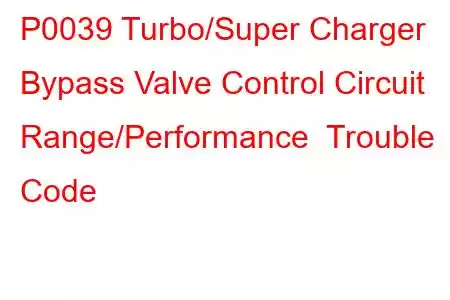P0039 Turbo Charger Bypass Valve Control Circuit Range Performance
OBD-II Trouble Code Technical Description
Turbo Charger Bypass Valve Control Circuit Range Performance
What does that mean?
This diagnostic trouble code (DTC) is a generic OBD-II powertrain code. It is considered generic because it applies to all makes and models of vehicles (1996-newer), although specific repair steps may vary depending on the make and model.
Owners of these these brands may include but are not limited to VW, Dodge, Saab, Pontiac, Ford, GM, etc.
A code P0039 Turbo/Super Charger Bypass Valve Control Circuit Range/Performance is stored in turbocharged and supercharged vehicles when the powertrain control module (PCM) has detected a turbocharger or supercharger boost pressure bypass valve control circuit malfunction. A service engine soon lamp may also be illuminated. If this code is exhibited in a vehicle that is not turbocharged or supercharged, suspect a PCM programming error.
The boost pressure bypass valve is an electronically controlled valve that is constructed to relieve turbo/supercharger boost pressure before it exceeds the manufacturer’s specified limit (usually between nine and fourteen-pounds). This is necessary in order to relieve potentially harmful (to the engine) boost pressure levels in the event of a turbo/supercharger malfunction. The boost pressure bypass valve is controlled by the powertrain control module (PCM) or a separate boost pressure control module. More often than not, the boost controller is an integrated part of the PCM. The boost controller gathers input signals from various engine sensors and uses them to calculate the optimum degree of turbo/supercharger boost pressure. The boost pressure bypass valve is then activated, using an electronic solenoid, electric motor, or vacuum control valve to achieve the desired amount of boost pressure. If the boost pressure sensor delivers an input signal to the PCM that indicates an inability to successfully control boost pressure, this code will be stored. Additionally, if the PCM detects an input voltage signal that is not within programmed limits, for a specified amount of time and under certain circumstances, a P0039 Turbo/Supercharger Bypass Valve Control Circuit Range/Performance code may be stored.
Turbo/supercharger bypass control valve operation is normally accomplished using a solenoid or a small electric motor. Vacuum operated valves are used on some models but this is design is much less common. The PCM supplies a direct voltage signal in order to activate electronically controlled valves but vacuum actuated valves are controlled using a vacuum control (or vacuum service) solenoid. The vacuum service solenoid is usually supplied with constant voltage and the PCM outputs a ground signal when the valve must be opened to relieve boost pressure. The valve closes automatically when the ground signal is stopped by the PCM. The vacuum actuated bypass valve is controlled using a voltage signal from the PCM applied to a vacuum service solenoid. Opening and closing the solenoid permits engine vacuum to the reach the valve (as required) to actuate opening. Consult the manufacturer’s service manual (or equivalent) for turbo/supercharger bypass control system specifications before beginning a diagnosis.
Code Severity & Symptoms
The conditions for causing this code to be stored can lead to major engine damage from excessive turbocharger boost pressure; therefore this code should be treated urgently.
Symptoms of a P0039 engine code may include:
A significant reduction in engine performance Hissing noises from the turbocharger (and/or hoses) or the supercharger Engine and/or transmission temperatures could be higher than normal Excessive exhaust system smoke Spark plug fouling Cylinder detonation, caused by hotter engine temps, are also a possibilitRead: 49


